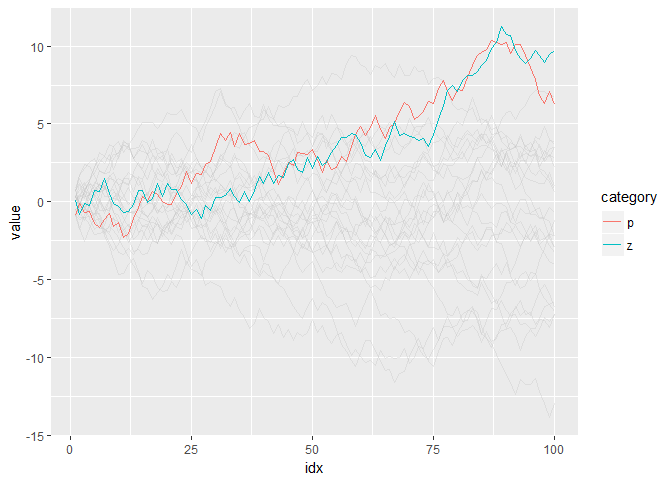(Sorry for posting a vague question here, but I think SO or GitHub issues are not appropriate place to ask this so RStudio Community is my only hope...)
Hi. I'm trying to create an extension of ggplot2, which enables to interactively highlight data series with dplyr and tidyeval.
GitHub: GitHub - yutannihilation/gghighlight: Highlight points and lines in ggplot2
Example:
library(gghighlight)
library(ggplot2)
# generate dummy data
set.seed(1)
genenerate_series <- function(cat) {
data.frame(idx = 1:100, value = cumsum(runif(100, -1, 1)), category = cat,
stringsAsFactors = FALSE)
}
d <- purrr::map_dfr(letters, genenerate_series)
# plot
ggplot(d) +
geom_highlighted_line(max(value) > 10, aes(idx, value, colour = category))

Seems easy? The code above is OK, as the mapping is provided to the layer so that the layer knows enough information to construct a predicate function from the expression max(value) > 20.
But, if the mapping is provided only on the other layer, it fails; I want to filter them by grouped manner, but there are no means to know which key will be used to split data into groups.
ggplot(d, aes(idx, value, colour = category)) +
geom_highlighted_line(max(value) > 10)
A simplified version of my implementation is bellow:
build_grouped_filter_func <- function(predicate, key) {
function(df) {
df_grouped <- dplyr::group_by(df, !! key)
df_filtered <- dplyr::filter(df_grouped, !! predicate)
dplyr::ungroup(df_filtered)
}
}
geom_highlighted_line <- function(.predicate, mapping, ...) {
predicate <- rlang::enquo(.predicate)
key <- mapping$colour
filter_func <- build_grouped_filter_func(predicate, key)
mapping_orig <- mapping
mapping$group <- key
list(
# grey layer
geom_line(mapping = mapping, colour = unhighlighted_colour),
# coloured layer
geom_line(data = filter_func, mapping_orig, ...)
)
}
IIUC, when creating a Geom or Stat object, it is too early to know what mappings will be used. On the other hand, customizable method of Geom or Stat (e.g. compute_group) is too late, as the data passed to them are already aes-mapped, with which the quoted expression can be no more evaluated.
Is it possible for a layer to know the other layer's raw data and mappings? Any advice is appreciated.
